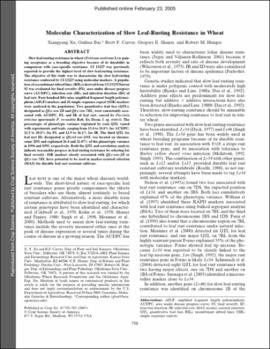| dc.contributor.author | Xu, Xiangyang | |
| dc.contributor.author | Bai, Guihua | |
| dc.contributor.author | Carver, Brett F. | |
| dc.contributor.author | Shaner, Gregory E. | |
| dc.contributor.author | Hunger, Robert M. | |
| dc.date.accessioned | 2015-10-16T20:47:52Z | |
| dc.date.available | 2015-10-16T20:47:52Z | |
| dc.date.issued | 2005-02-23 | |
| dc.identifier | okds_Carver_CS_2005-02-23.pdf | |
| dc.identifier.citation | Xu, X., Bai, G., Carver, B. F., Shaner, G. E., & Hunger, R. M. (2005). Molecular characterization of slow leaf-rusting resistance in wheat. Crop Science, 45(2), 758-765. https://doi.org/10.2135/cropsci2005.0758 | |
| dc.identifier.uri | https://hdl.handle.net/11244/19804 | |
| dc.description.abstract | Slow leaf-rusting resistance in wheat (Triticum aestivum L) is gaining acceptance as a breeding objective because of its durability in comparison with race-specific resistance. CI 13227 was previously reported to provide the highest level of slow leaf-rusting resistance. The objective of this study was to characterize the slow leaf-rusting resistance conferred by CI 13227 using molecular markers. A population of recombinant inbred lines (RILs) derived from CI 13227/Suwon 92 was evaluated for final severity (FS), area under disease progress curve (AUDPC), infection rate (IR), and infection duration (ID) of leaf rust. Four hundred fifty-nine amplified fragment length polymorphism (AFLP) markers and 28 simple sequence repeat (SSR) markers were analyzed in the population. Two quantitative trait loci (QTL), designated as QLr.osu-2B and QLr.osu-7BL, were consistently associated with AUDPC, FS, and IR of leaf rust, caused by Puccinia triticina (previously P. recondita Rob. Ex Desm. f. sp. tritici). The percentages of phenotypic variance explained by each QTL varied with experiments and traits, ranging from 13.4 to 18.8% for AUDPC, 12.5 to 20.8% for FS, and 12.9 to 16.1% for IR. The third QTL for leaf rust ID, designated as QLrid.osu-2DS, was located on chromo- some 2DS and explained 26.4 and 21.47% of the phenotypic variance in 1994 and 1995, respectively. Both the QTL and correlation analysis indicate reasonable progress in leaf-rusting resistance by selecting for final severity. SSR markers closely associated with QLr.osu-2B or QLr.osu-7BL have potential to be used in marker-assisted selection (MAS) for durable leaf rust resistant cultivars. | |
| dc.format | application/pdf | |
| dc.language | en_US | |
| dc.publisher | Crop Science Society of America | |
| dc.rights | This material has been previously published. In the Oklahoma State University Library's institutional repository this version is made available through the open access principles and the terms of agreement/consent between the author(s) and the publisher. The permission policy on the use, reproduction or distribution of the material falls under fair use for educational, scholarship, and research purposes. Contact Digital Resources and Discovery Services at lib-dls@okstate.edu or 405-744-9161 for further information. | |
| dc.title | Molecular characterization of slow leaf-rusting resistance in wheat | |
| osu.filename | okds_Carver_CS_2005-02-23.pdf | |
| dc.description.peerreview | Peer reviewed | |
| dc.identifier.doi | 10.2135/cropsci2005.0758 | |
| dc.description.department | Plant and Soil Sciences | |
| dc.description.department | Entomology and Plant Pathology | |
| dc.type.genre | Article | |
| dc.type.material | Text | |
